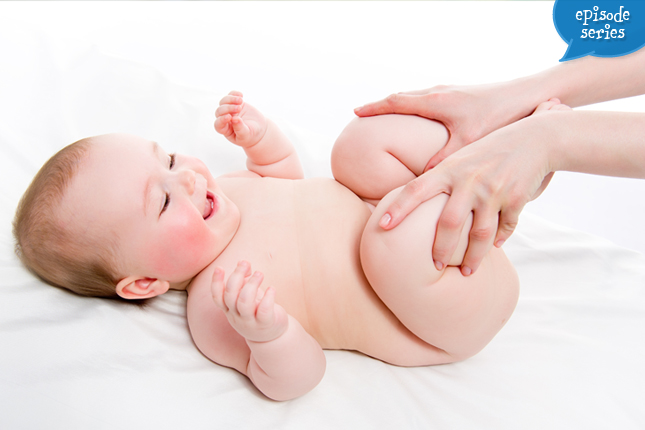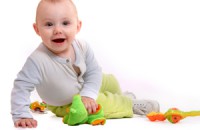Parent Savers
Baby Skin Conditions: All About Rashes
[00:00:00]
Please be advised, this transcription was performed from a company independent of New Mommy Media, LLC. As such, translation was required which may alter the accuracy of the transcription.
[Theme Music]
DR. FREDERICK JOHNSON: Rashes on babies are inevitable. They can be pink bumps, bright red blotches or something else altogether. Each one tells us something diffesrent about how the skin is irritated. I’m Frederick Johnson, former chief of pediatrics at Sharp Mary Birch Hospital for women and newborns. And today we’re talking all about rashes. This is parent savers, episode 93.
[Theme Music/Intro]
JOHNER RIEHL: Welcome everybody to Parent Savers broadcasting from the Birth Education Center of San Diego. Parent Savers is your weekly online, on-the-go support group for parents from the newborn years through kindergarten. I’m your host Johner Riehl, thanks again to all of our loyal listeners who join us week in and week out. And thanks to those who are listening for the first time. As you may know you can listen to our Parent Savers club. You can join our parent savers club and you will receive access to special bonus content after each new show, plus some other special aspects as well of being a member so, make sure to check that out. If you’re liking what we’re doing, please join us and get the extra awesome goodies. If you haven’t already please make sure to download the free parent savers app you can get it for android and iPhone and iPad and then you’ll automatically have access to all the great parenting advice and conversation we have on parent savers every week.
Let’s start today’s conversation by meeting everyone who is joining us in the room and talk all about rashes. I’m Johner Riehyl, I’m your host. I have three boys, a seven year old, a five year old and a two year old. And really it’s the two year old that’s given us most of the problems with the rashes. So, it’s, what the third all in. I feel like I’m saying that it’s the two year old, it’s the two year old but, he’s a rashy guy as well. So, how about you guys.
SUNNY GAULT: Hey everyone I’m Sunny, I’m mommy to four children now. I have a three and a half year old and almost two year old and twin identical girls. My older two children are boys so, two on two. And I’m owner of new mommy media which produces this show as well as a few others. Yeah, happy to be here. All my kids have had rash, well actually not the girls, the girls have not had any real rashes yet. Of course they’re two and a half months old, so that’s they just haven’t grown into their rash stage yet. Actually my middle guy is a, he gets a lot of the diaper kind of rashes, so, yeah I got a lot of questions about that.
ERIN ESTEVES: Hmmm… the nose crinkled when you said that. So, I’m Erin, otherwise known as Oh Gee Mama Sitta, officially. That’s right, and I have one boy he’s two-ish. And yeah, funky rashes. Woohoo!
JOHNER RIEHL: He’s rash-ish.
ERIN ESTEVES: He’s rash-ish. Yeah
JOHNER RIEHL: And then Doctor Johnson?
DR. FREDERICK JOHNSON: I actually, I guess Oh Gee also.
ERIN ESTEVES: Hey !
DR. FREDERICK JOHNSON: And I win the org I have five kids.
JOHNER RIEHL: Nice!
DR. FREDERICK JOHNSON: But my youngest was twenty seven.
JOHNER RIEHL: So are we going to talk about their rashness.
ERIN ESTEVES: I hope you don’t know much about their rashes.
DR. FREDERICK JOHNSON: I have five and a half grand children.
JOHNER RIEHL: Oh nice!
DR. FREDERICK JOHNSON: One’s due in June. So I still see rashes all the time. Of course in the office too.
[Theme Music]
JOHNER RIEHL: Now we have a question from Robin. Robin writes: We bought this beautiful crib bedding for our first child complete with a mobile that hangs over the crib. And now with our second child the mobile seems to get a bit of a problem. Our toddler likes to disassemble it and I’m worried on our nine month old baby may get hurt in the process especially if it happens at night since they sleep in the same room. Have there been any reports about mobiles being dangerous?
Hi, child safety expert. Robin, I researched the consumer product safety commission database that provides information on a variety of products and reports of injury. The database is a sample of cases and is based on a reporting systems through hospitals across the country. Having looked back at approximately five years, there are maybe five or six entries regarding mobile. The injuries include minor lacerations with a mobile falling on an infant’s head. Having said that, I think it’s important to recognize that a mobile is made up of number of different cords or strings which could be easy for a toddler and an infant to get entangled in. While there are no cases that I can find that point to entanglement or worse, if there’s a chance that a mobile might become unattached and end up in a crib? It might be a good idea to remove it all together. I hope that’s helpful.
[Theme Music]
JOHNER RIEHL: Today’s topic is baby skin conditions all about rashes. And we’re talking with Doctor Frederick Johnson, a former chief of pediatrics at Sharp Mary Birch Hospital for women and newborns. Thanks so much for joining us.
DR. FREDERICK JOHNSON: Thank you.
JOHNER RIEHL: So, let’s start generally talking about baby skin and toddler’s skin. And what is going through and why it gets rashes.
DR. FREDERICK JOHNSON: Well first of all I think with baby’s skin, just like the rest of the baby the skin goes through a transition in the newborn period. And you may have rashes which for the vast majority are completely harmless and self-limited. They occur because the skin’s going through changes in circulation, new exposures, things like that. And so, you get these rashes, I’m sure a lot of parents have seen a rash right on the second or third day of life. And go “what is this?”. And generally it’s a rash called erythema which can be completely self-limited. And by the end of the first week disappears.
Why you get rashes after the newborn period there’s a list that probably few hundred things. And so, I think every practitioner goes through a sort of system check when you see a rash. I think it’s interesting little story. Back when I was in med school. They used to have dermatology rounds. And so you get twenty, twenty five dermatologist and there be a patient in every room. And they had to come to some consensus about what each patient had and they never could. So, rashes sometimes are challenging and sometimes we go through our system approach and still not know what caused it or why it’s there. But we send them on sometimes to the dermatologist who may not know what’s causing this. And sometimes even has to take a little biopsy to figure out “what is this?” or culture.
JOHNER RIEHL: But for the most part, I mean if we go to the doctor with a rash you could figure it out or…
DR. FREDERICK JOHNSON: Oh yeah.
JOHNER RIEHL: Right.
ERIN ESTEVES: Well usually I mean there’s like just the, there’s a fungal and there’s abrasive right I mean those are…
DR. FREDERICK JOHNSON: Well there’s inflammatory, there’s infectious, there’s fungal, there’s contact, something you come in contact with that irritated the skin, So, again you go through that kind of approach. And sometimes, because I’m an Oh gee, who’s interesting just about a month ago, there is a mom that came into her OB and she’s like thirty eight weeks and she had a rash. Which, they couldn’t understand what it was. And so the OB came down to pediatrics and said “Can you come look at a rash?” Because they couldn’t find the skin doctor at the time and I went up and look at him and it turned out that the mom had chicken pox. Which, thirty eight weeks was a red flag. So we ended up treating the mom and she delivered a healthy baby without chicken pox. If she hadn’t been treated there was probably a twenty percent chance of mortality. So sometimes rashes are…
JOHNER RIEHL: And were you able to just kind of show up and say “Oh it’s like chicken pox”
DR. FREDERICK JOHNSON: Yeah but you know I showed up and did it because there’s a systematic approach again, you know chicken pox sort of its hallmark is it’s itchy. But all the different marks are in different stages. Not all in the same stage at the same time. And then you go through the history of you’re a head chicken pox and she hadn’t. And so you sort of match the history to what you see and come up with a diagnosis.
JOHNER RIEHL: Got it. Wow.
ERIN ESTEVES: Crazy.
JOHNER RIEHL: That is. What is, so we’re throwing about a bunch of terms, inflammatory, abrasive, fungal, and in researching, you know getting ready for the show. There’s all sorts of, there’s so many different types of rashes. So let’s maybe just talk about a few of them and maybe that will help some our listeners know what they’re looking at or if they’ve been concerned about rashes
ERIN ESTEVES: If there’s a fungus-a-mungus?
JOHNER RIEHL: Creepy. Right!
DR. FREDERICK JOHNSON: Well sometimes you have to look at rashes, so the neonatal period from birth to twenty eight days, if there is a rash. After that, because babies are exposed to this new environment, there could be all sorts of things that come up from inflammatory rashes like eczema. Is there a family history of allergy? What are they washing the baby with? Where does the baby lie or sleep? What kind of materials are around them? Are there other kids around who might be able to transmit the rashes?
JOHNER RIEHL: Well what makes it inflammatory? I mean is it like raised off the skin?
DR. FREDERICK JOHNSON: It can be raised, it can be red. It can be uncomfortable. But of course most babies can’t reach over and scratch themselves. So, they make move around in their bedding or their blanket sort of like they’re uncomfortable. So, can be raised, can be red. And the only thing about rashes is always “where is it?”. The distribution or location, is it on the arms? The neck? Or the face? Is it all over? Is it something you think is external, something that the baby has been in contact with. Or is it internal, something that from within that’s causing the rash. There are just…
JOHNER RIEHL: Each rash has its own CSI episode
DR. FREDERICK JOHNSON: It’s very much like that. It’s very much like that. You become Sherlock Holmes and you try and go through each little clue because the baby’s not going to tell you. So, you try and figure out from where it’s located. What it looks like? How long it’s been there? And hopefully come up with a correct diagnosis and treatment if needed.
JOHNER RIEHL: Right. And we’ll talk after we take a break some of the treatments. But, what about, you know, blisters? Like if somebody showed up with blisters, that’s a
DR. FREDERICK JOHNSON: Well blisters, again it has to do with distribution. One of the things I try and do is through that systematic approach I use is can I describe this rash to somebody without them looking at it and make them visualize what the rash is. So, a blister, single blister is one thing. If blisters are in groups or clusters, then, especially in newborn period, you become very concerned about things like herpes. And herpes is another thing that you have to address right away. Especially in newborn period because the herpes virus cannot only affect the skin, it can affect other organs, including the brain.
JOHNER RIEHL: Are blisters the biggest red flag that you might see oozing of, like what are some of the big warning signs of rash
DR. FREDERICK JOHNSON: Blisters, especially in clusters or group is one big warning sign. Just a flat red rash sometimes with a bluish hue that occupies say a single limb or around the eye, or the orbit is another one that we become quite concerned with because if the circulation of these rashes is apparent externally, there may be some problem internally.
JOHNER RIEHL: So, slightly bluish it might mean that it’s impeding blood flow?
DR. FREDERICK JOHNSON: Well there is blood flow and is there abnormal blood flow below that rash? Especially around the brain.
JOHNER RIEHL: Yikes!
ERIN ESTEVES: Yeah I just never put those two together. I never thought of a rash being anything other than red. You know, I never thought of it having a discoloration like that
JOHNER RIEHL: Yeah. Is that a big warning sign?
DR. FREDERICK JOHNSON: Yeah rashes can be red but they can sometimes just be skin colored. There are some rashes, you know rashes sort of like, I guess you call them skin lesions. But there are some rashes that maybe indicative of a problem now. There are rashes that maybe indicative of a problem later. There’s some rashes like on the scalp that looks like an orange peel. If there’s a certain nevus that you want to address right away also.
JOHNER RIEHL: Are there any rashes that you, that there’s some symptoms like, alright let’s on that big of a do, we just need to deal with it. Cause we’re talking about scary rashes but you know if it’s just, you know, just a little red patchy area on a couple of places around the body
DR. FREDERICK JOHNSON: Well again, you go through your systematic approach. And you try and figure out what’s causing this rash. We see a lot of kids especially in the infant stage who have early eczema. And that’s a very common problem. So you try and figure out what’s irritating the skin or the child. Is it what they’re eating? Is it what they’re touching?
JOHNER RIEHL: Is it the air? Right? It disappear.
ERIN ESTEVES: Is it excessive drooling brought on by teething? Which is one of the questions that I got from facebook? Yes, so this mother’s saying that her child broke out in a rash around his mouth and down his neck. And it kind of look like eczema but she wasn’t sure. And it came long the same time that his excessive drooling started.
DR. FREDERICK JOHNSON: Which could be more irritative and then you know you kind of saliva is just sort of innocuous etc. But you know it does contain remnants of what you’ve eaten. At times it can be acidic and that’s what’s causing the irritation too on the skin. As they get older, sometimes you have to go in to what they’ve eaten because certain foods could use of that when it gets on the skin and they’re exposed to the light they’ll break out.
ERIN ESTEVES: Oh!
DR. FREDERICK JOHNSON: Citrus
JOHNER RIEHL: That remind me of my seven year old, he’s a rashy one actually. Again with the saliva, he’s got his crazy long tongue like he can touch the tip of his nose with his tongue. It’s crazy. But so he, you know he licks his lips and so but instead of just having it right around his lips where he gets a rash. He gets like this huge goatee of rash.
ERIN ESTEVES: Like a clown smile
JOHNER RIEHL: Yeah, exactly.
DR. FREDERICK JOHNSON: The other thing that sometimes can come from the mouth though and you know sometimes you see it as thrush is a fungal elements. And so fungi always live in your mouth, in your whole gut. And sometimes those can cause the irritation too. And sometimes you have to even take a little scraping or do a little test on the skin to see if it’s fungal or whether it’s just skin that’s irritated.
JOHNER RIEHL: Alright well let’s take a quick break here. We’ve talked a lot about, we all pry itching and feeling very uncomfortable in our skin. So let’s talk about treating it when we come back and I think we got a couple of more questions from you all on facebook. So, we’ll be right back.
[Theme Music/Intro]
JOHNER RIEHL: Welcome back everybody. Today we’re talking about baby skin conditions all about rashes with Doctor Frederick Johnson. Thanks for joining us. So, we’re going to talk about treatments but before we do, Doctor Johnson just told us that he can make us itch. And so Erin was like “no way”, and I’m like “let’s do it” So, let’s see, let’s see
DR. FREDERICK JOHNSON: All I have to say is one word, “scabies”
ERIN ESTEVES: Ewwwww
SUNNY GAULT: Well what if you don’t know, I really don’t know exactly what scabies are
ERIN ESTEVES: I don’t really know what scabies are
SUNNY GAULT: Well yeah I, I don’t know it’s just a bad word
JOHNER RIEHL: What is scabies?
DR. FREDERICK JOHNSON: Scabies is a mite that can burrow into the skin.
JOHNER RIEHL: I’m totally scratching over here
DR. FREDERICK JOHNSON: And it’s extremely itchy. And so whenever you see that in the office, all the nurses starts scratching and I start scratching. Totally treatable but ugh!
JOHNER RIEHL: Yeah. But as a doctor you can’t do that in the room though. The he just did a shudder like, you can’t do that
DR. FREDERICK JOHNSON: No I have to leave the room
JOHNER RIEHL: Yeah and then go “Oh!”
ERIN ESTEVES: See I think for me, the bed bugs. Seeing bed bugs would in site are much more of like a creepy
DR. FREDERICK JOHNSON: It’s sort of same principle having a bug on your skin and causing
SUNNY GAULT: No under your skin is much worse
JOHNER RIEHL: Alright, let’s talk about treating scabies or other thing. Is there any, is there magic ointment that you can recommend that is, for parents to have on hand?
ERIN ESTEVES: Well that’s part of one of the facebook questions was that, somebody commented that their grandmother used to put a combination of butter and baking soda. Kind of like the windex.
DR. FREDERICK JOHNSON: You can do that but you have to flip them over
JOHNER RIEHL: And don’t do that in fall springs in the summer
DR. FREDERICK JOHNSON: Right
ERIN ESTEVES: On everything like the slightest information, be like “Oh here’s some baking soda and butter” That’s all I got
DR. FREDERICK JOHNSON: Well you know, sometimes you hear those old sort of wives tales and remedies trend. They actually, some of them, and I won’t say baking soda and butter but might have some purpose. For instance, like the acidic drool. If you can reduce the acidity you can reduce the inflammation. And so baking powder might actually do that and butter is just the adherent for it
ERIN ESTEVES: Gotcha!
DR. FREDERICK JOHNSON: Won’t work for everything
JOHNER RIEHL: I think that I’m going to start carrying around a spray bottle of tequila
ERIN ESTEVES: You have to keep it in the trunk caused you ever got pulled over there would be an open container
JOHNER RIEHL: That’s true
DR. FREDERICK JOHNSON: But, as far as some magic potion for everything. There’s just isn’t one
JOHNER RIEHL: I wasn’t asking for a lot but there are things that can be useful for a lot of rashes?
ERIN ESTEVES: Honey?
JOHNER RIEHL: Honey? Sweetie?
DR. FREDERICK JOHNSON: Actually, you know, for and it kind of depends, I mean if you have a family history of eggs and more allergies and both sides of the family. It may not be a bad idea just to have, this is more for infants, so, Benadryl available and the over the counter hydrocortisone
JOHNER RIEHL: Okay. Just to have it to be able to put on
DR. FREDERICK JOHNSON: Just to have it around. Sort of in your first aid kit.
JOHNER RIEHL: With Vaseline is that something that’s helpful or
DR. FREDERICK JOHNSON: Well moisturizers are amazingly helpful. You know we all have this, or a lot of people do have this idea that if you put a moisturizer on once during the day, that’s all you need. So, most of those moisturizers will a few hours or within a few hours sometimes minutes gone. And so sometimes you have to reapply it. So having a good moisturizer, hypo allergenic non-scented would also be good.
ERIN ESTEVES: You just described honey
DR. FREDERICK JOHNSON: Except for the flies and the bees
JOHNER RIEHL: And the stickiness aspect
ERIN ESTEVES: Well that’s why you put gauze over it, you know, I’m just saying, I like honey
JOHNER RIEHL: Do you put honey on Cash?
ERIN ESTEVES: I put honey on burns and I actually use it as a facial and yeah, all kinds of stuff
DR. FREDERICK JOHNSON: Now there’s honey. What kind of honey do you use?
ERIN ESTEVES: Raw honey
DR. FREDERICK JOHNSON: Okay cause under year of age we don’t like using
ERIN ESTEVES: On cracks, yeah he is too-ish
SUNNY GAULT: She’s got a hive on their backyard and she goes in every time
DR. FREDERICK JOHNSON: But they did put honey on a lot of skin products
ERIN ESTEVES: Yeah. And in soaps and shampoos and stuff
JOHNER RIEHL: Cereal
ERIN ESTEVES: And toast
JOHNER RIEHL: We talked a little about causes for a warm with the blisters and the lesions. So what would you do in that case? Is it antibiotics?
DR. FREDERICK JOHNSON: Depending on you know what I see, and then sometimes we can do skin cultures to find out what’s going on. We may use antibiotics either topically or by mouth. If a rash is spreading, if let’s say you have a red rash that one day looks the size of a penny and the next day it’s a size of a quarter, that’s probably cause for alarm.
JOHNER RIEHL: Okay if you can see a growth
DR. FREDERICK JOHNSON: Yes especially if the rapid growth
JOHNER RIEHL: Right. Cause it should be if it was an irritation it would be irritated or not and not necessarily the spreading thing
DR. FREDERICK JOHNSON: Right. And then of course, the skin is actually the largest organ you have in the body that fights disease. So, any break in the skin and you’re liable to get some secondary infection. So, you want to watch for that also. And of course if there’s any pus coming from it, if the child is febrile, doesn’t want to use that area let’s say it’s on the arm or the leg. And all of a sudden they don’t want to walk or use the arm then that’s cause for alarm too.
ERIN ESTEVES: Febrile, is that feverish?
DR. FREDERICK JOHNSON: Right
ERIN ESTEVES: Okay
JOHNER RIEHL: Does water provide relief for a lot of rashes? Or can it be bad for some rashes?
DR. FREDERICK JOHNSON: I guess you have to ask, what’s in the water?
ERIN ESTEVES: Tequila!
JOHNER RIEHL: Right, tequila. Or tap water or swimming. And swimming can exacerbates rashes right?
DR. FREDERICK JOHNSON: Well swimming, of course if you’re swimming in a pool, then, it’s not just water. Its water plus some chemical in it
JOHNER RIEHL: Right
DR. FREDERICK JOHNSON: So that can be irritating just being out in the sun along with that could be irritating. Again you have to go through sort of a whole checklist of what’s what up to this
JOHNER RIEHL: That’s why you go to med school
DR. FREDERICK JOHNSON: Exactly
ERIN ESTEVES: Interrogating you
SUNNY GAULT: Can I just ask specifically about diaper rashes cause I feel like that’s a huge thing that our audience is dealing with probably on the somewhat regular basis. So, when you see a diaper rash, you know they got all these creams and lotions and without using a bunch of you know brand names or whatever like. Is there something that you recommend? I find that, you know, I use A & D on my kids quite a bit to try that create that barrier. So, you know if I don’t get to their diaper right away or whatever you know, it’s not eating away at their skin, so I try to do that
JOHNER RIEHL: What’s A & D?
SUNNY GAULT: Oh A & D ointment? What does that stand for I don’t even know. Do you know?
DR. FREDERICK JOHNSON: No
SUNNY GAULT: But it’s called A & D
JOHNER RIEHL: So, every time you change a diaper you put ointment on
SUNNY GAULT: Yes I do. It’s a barrier that protects
JOHNER RIEHL: Even if you don’t see a rash
SUNNY GAULT: Even if I don’t see a rash. I do it preemptively
DR. FREDERICK JOHNSON: People have used A & D sometimes they use Desitin. The primary age and practically all of these is zinc oxide. It creates a barrier that can prevent further infection or irritation. With diaper rash, that’s sort of important to me, where is the diaper rash? Is it around the genitals? Is it around the anus or is it around both? Usually if it’s around the genitals and it’s kind of splotchy red and there’s little bumps around and that’s usually a yeast infection. And so, the barrier creams wouldn’t help with that, so you might want to try an anti fungal. If it’s around the anus, and it’s bright red and it’s very uncomfortable. Once you touch it and the baby’s just wincing or starts crying then there might be what we call a strep infection, which is bacteria. And so, that way we treat differently with either again topical or oral antibiotics
SUNNY GAULT: Yeah my oldest actually have that and I think it was for, it was like a progression of a diaper rash that just got worse. And I kept trying to just use A & D, you know like my normal drill and it just wasn’t working. Yeah and we had to get like a topical antibiotic to put on. And then there’s another one that’s over the counter I think it’s just called Triple Antibiotic.
DR. FREDERICK JOHNSON: Right.
SUNNY GAULT: Okay. So that kind of is my in between go to where I don’t think it’s something that the doctor has to see yet but A & D is not working. I’ve got like a method here. And then I think, is that more for like if it starts to be a little open wound-ish does that in that kind of?
DR. FREDERICK JOHNSON: You mean the triple antibiotic?
SUNNY GAULT: Yeah, triple antibiotic.
DR. FREDERICK JOHNSON: It can help with that. But again, if it’s starting to spread and the baby’s becoming more irritable, then they need more than that.
SUNNY GAULT: Okay. Usually, I’ll go to that before. You know because like, you know it gets to a stage where okay my son doesn’t want me to touch him. Then I’ll reach for the triple antibiotic like I put that on him. And then, in a day or so if it’s not looking better, then that’s when I call the doctor.
DR. FREDERICK JOHNSON: And if the rash is like a diaper rash that isn’t what I described as fungal and it’s not around the anus, there’s may be a splotch or two. The best thing is not water but air. Just leaving the diaper open and letting it air dries sometimes it’s immensely helpful.
JOHNER RIEHL: Got it.
ERIN ESTEVES: Nothing else might be dry around the kid afterwards.
DR. FREDERICK JOHNSON: Well you have to prepare.
JOHNER RIEHL: I feel like when our kids have gone on antibiotics before, the doctors have tried to give us some preemptive measures to prevent diaper rash too. That because they knew that that was going to make them have diarrhea or I think just really be really prone to the diaper rash. I think there was a culture there like strepto wait not streptococcus but, something that the health in store or yogurt. Have you ever heard of that?
ERIN ESTEVES: Acidophilus
DR. FREDERICK JOHNSON: Acidophilus. Streptococcus?
JOHNER RIEHL: That will be a really bad. Why don’t take some e-coli and that will make you feel very.
ERIN ESTEVES: Eat some poo yeah
JOHNER RIEHL: But, I mean are there things that preemptive measures to help prevent rashes
DR. FREDERICK JOHNSON: Well you know, using probiotics or things like that have been immensely helpful. Not hundred percent but it’s always worth a try. And then sometimes, if you’re getting a lot of diaper rash, you know just asking yourself, “why?” Yeah. Is it that you only see a diaper rash when the kid comes home from day care or do you see the diaper rash at home because it may just be a function of how often is their diaper changed cause you know poop is a lot of bacteria in it. And there’s a lot of things that kind of word that get dumped into the diaper. And sometimes can be very irritative and uncomfortable
JOHNER RIEHL: Now it does good point to bring up Sunny for sure. So, let’s well we talked I guess about a lot of over the counter medicines or any kind of final recommendations that you’d recommend for parents to have on hand, to have in the medicine cabinet, and be ready. And maybe they call the nurse hotline and they’ll say “oh this is maybe what you need”
DR. FREDERICK JOHNSON: Well just like I talked about my system for looking at rashes. When you try and describe a rash to someone else, especially over the phone, try and remember how long it’s been there, what it looks like, where it is and if it’s spread. And just have that information available and sometimes we can just take it from there
JOHNER RIEHL: Okay.
DR. FREDERICK JOHNSON: One of the things that has happen and will probably be happening a lot more in the future is telemedicine. Which means, you know we all have smartphones and ipads etc and you can actually, if you get the right resolution. Take a picture of the rash and send it to the doctor and they can send back what they think it is. Whether or not you need to be seen or not. So it may save you on office visit. But the problem sometimes is just the resolution cause most phones aren’t, they don’t really capture the picture of the image.
JOHNER RIEHL: And the lighting would be right to see some of the detail. But it is interesting and I something that we forget. We’ve got these cameras in our pocket, take pictures of things then that could help even when you go
DR. FREDERICK JOHNSON: And then some parents will do that and bring it in to the office if they come in then that really kind of help
JOHNER RIEHL: Well that’s actually what we’ll talk about for our bonus content for our listeners is if you are going to the doctor’s office, what you can do to help present to the doctor and give them the information. So, we’ll wrap up today’s conversation with Doctor Johnson, thanks so much for joining us.
For more information about the topic, you can go to our website www.parentsavers.com and you can also join our parent savers club there where you can have access to our great bonus content. Where we talk about topics in a bit more we have a bonus question at the end. And this week we’re going to talk more about what to do when you do go to the doctor’s office. What are some good things to bring in? So thanks so much for joining us. We’ll be right back.
[Theme Music]
BRIAN MILLER: Hello parent savers I’m Brian Miller, I’m the owner of Geppetto’s toy stores here in San Diego. And I’m going to talk to you about toys for your six month old to about one year old. Toys for that age are so exciting. At that age your children are just exploring everything. With their fingers, with their toes, with their mouths. The more colorful the better. Things that are easy to grasp. But that six months age of your child is really learning their pins or grasps. Their forefinger and their thumbs. So things that are easy to pick up are great small motor skill for that age. Teething. Part of exploration is putting things in their mouths so you want to make sure there’s safe. You want to make sure no small parts. Don’t put ant toys in the freezer cause that’ll hurt their gums. But a cold toy sometimes feels good.
Things that are made for teething are really important. Also your child’s larger motor skills are working at that time. At about six months to nine months they’re sitting up so things that can sit on the floor where they’re going to play with them maybe nesting blocks or soft stacking blocks, something that can stack and can tumble over. That’s very fun. Also time on their tummy. Tummy time is really important so things with sound cause your child to turn and listen and see what’s going on. At the end of that stage or nine months to a year, cause and effect. Kids love to see what you can do to make a toy change or make it make noise. So this toy telephone by turning the knob making it ring, that’s a cause and effect toy. Also peek a boo, object permanence.
When you see something and it’s on and then it comes back, that’s why kids love peek a boo that’s a skill they’re learning, object permanence. And then as they’re going toward a year, larger motor skills. They’re starting to walk, they’re starting to crawl. When they’re crawling something as simple as a ball could motivate a child to crawl. And then as they begin to walk they’re going to be cruising, so walking around the table, or even a walker that’s very-very stable is great for a child of that age. You can visit our website www.geppettostoys.com for more information or for future ideas; listen to parent savers for more toy tips in the future
[Theme Music]
JOHNER RIEHL: That wraps things up for today’s episode of parent savers. Thank you so much for listening. Don’t forget to check out our other new mommy media shows, there’s Preggie Pals for expecting parents, The Boob Group for moms who breastfeed and Twin Talks for parents of multiples. Next week we’re going to be talking about picky eaters which is a topic that just like rashes I think all of these are dealing with our kids and if not then everybody hates you because you have kids who are picky eaters. This is parent savers empowering new parents
[Disclaimer]
This has been a New Mommy Media production. Information and material contained in this episode are presented for educational purposes only. Statements and opinions expressed in this episode are not necessarily those of New Mommy Media and should not be considered facts. Though information in which areas are related to be accurate, it is not intended to replace or substitute for professional, Medical or advisor care and should not be used for diagnosing or treating health care problem or disease or prescribing any medications. If you have questions or concerns regarding your physical or mental health or the health of your baby, please seek assistance from a qualified health care provider.
[00:35:45]
[End of Audio]












